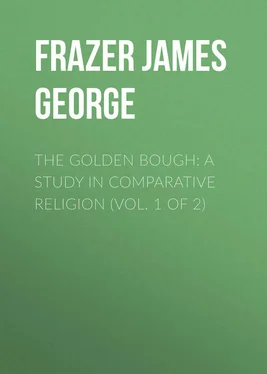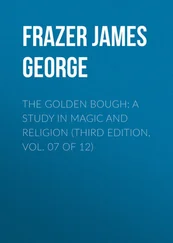James Frazer - The Golden Bough - A Study in Comparative Religion (Vol. 1 of 2)
Здесь есть возможность читать онлайн «James Frazer - The Golden Bough - A Study in Comparative Religion (Vol. 1 of 2)» — ознакомительный отрывок электронной книги совершенно бесплатно, а после прочтения отрывка купить полную версию. В некоторых случаях можно слушать аудио, скачать через торрент в формате fb2 и присутствует краткое содержание. Жанр: foreign_religion, foreign_antique, foreign_prose, на английском языке. Описание произведения, (предисловие) а так же отзывы посетителей доступны на портале библиотеки ЛибКат.
- Название:The Golden Bough: A Study in Comparative Religion (Vol. 1 of 2)
- Автор:
- Жанр:
- Год:неизвестен
- ISBN:нет данных
- Рейтинг книги:4 / 5. Голосов: 1
-
Избранное:Добавить в избранное
- Отзывы:
-
Ваша оценка:
- 80
- 1
- 2
- 3
- 4
- 5
The Golden Bough: A Study in Comparative Religion (Vol. 1 of 2): краткое содержание, описание и аннотация
Предлагаем к чтению аннотацию, описание, краткое содержание или предисловие (зависит от того, что написал сам автор книги «The Golden Bough: A Study in Comparative Religion (Vol. 1 of 2)»). Если вы не нашли необходимую информацию о книге — напишите в комментариях, мы постараемся отыскать её.
The Golden Bough: A Study in Comparative Religion (Vol. 1 of 2) — читать онлайн ознакомительный отрывок
Ниже представлен текст книги, разбитый по страницам. Система сохранения места последней прочитанной страницы, позволяет с удобством читать онлайн бесплатно книгу «The Golden Bough: A Study in Comparative Religion (Vol. 1 of 2)», без необходимости каждый раз заново искать на чём Вы остановились. Поставьте закладку, и сможете в любой момент перейти на страницу, на которой закончили чтение.
Интервал:
Закладка:
“Gentlemen and ladies,
We wish you happy May;
We come to show you a garland,
Because it is May-day.”
On receiving money the lord put his arm about his lady's waist and kissed her. 330 330 Brand, Popular Antiquities , i. 233 sq. Bohn's ed.; Mannhardt, B. K. p. 424.
In some Saxon villages at Whitsuntide a lad and a lass disguise themselves and hide in the bushes or high grass outside the village. Then the whole village goes out with music “to seek the bridal pair.” When they find the couple they all gather round them, the music strikes up, and the bridal pair is led merrily to the village. In the evening they dance. In some places the bridal pair is called the prince and the princess. 331 331 E. Sommer, Sagen, Märchen und Gebräuche aus Sachsen und Thüringen , p. 151 sq. ; Mannhardt, B. K. p. 431 sq.
In the neighbourhood of Briançon (Dauphiné) on May Day the lads wrap up in green leaves a young fellow whose sweetheart has deserted him or married another. He lies down on the ground and feigns to be asleep. Then a girl who likes him, and would marry him, comes and wakes him, and raising him up offers him her arm and a flag. So they go to the alehouse, where the pair lead off the dancing. But they must marry within the year, or they are treated as old bachelor and old maid, and are debarred the company of the young folk. The lad is called the bridegroom of the month of May ( le fiancé du mois de May ). In the alehouse he puts off his garment of leaves, out of which, mixed with flowers, his partner in the dance makes a nosegay, and wears it at her breast next day, when he leads her again to the alehouse. 332 332 This custom was told to Mannhardt by a French prisoner in the war of 1870-71, B. K. p. 434.
Like this is a Russian custom observed in the district of Nerechta on the Thursday before Whitsunday. The girls go out into a birch-wood, wind a girdle or band round a stately birch, twist its lower branches into a wreath, and kiss each other in pairs through the wreath. The girls who kiss through the wreath call each other gossips. Then one of the girls steps forward, and mimicking a drunken man, flings herself on the ground, rolls on the grass, and feigns to go fast asleep. Another girl wakens the pretended sleeper and kisses him; then the whole bevy trips singing through the wood to twine garlands, which they throw into the water. In the fate of the garlands floating on the stream they read their own. 333 333 Mannhardt, B. K. p. 434 sq.
In this custom the rôle of the sleeper was probably at one time sustained by a lad. In these French and Russian customs we have a forsaken bridegroom, in the following a forsaken bride. On Shrove Tuesday the Slovenes of Oberkrain drag a straw puppet with joyous cries up and down the village; then they throw it into the water or burn it, and from the height of the flames they judge of the abundance of the next harvest. The noisy crew is followed by a female masker, who drags a great board by a string and gives out that she is a forsaken bride. 334 334 Ib. p. 435.
Viewed in the light of what has gone before, the awakening of the forsaken sleeper in these ceremonies probably represents the revival of vegetation in spring. But it is not easy to assign their respective rôles to the forsaken bridegroom and to the girl who wakes him from his slumber. Is the sleeper the leafless forest or the bare earth of winter? Is the girl who wakens him the fresh verdure or the genial sunshine of spring? It is hardly possible, on the evidence before us, to answer these questions. The Oraons of Bengal, it may be remembered, celebrate the marriage of earth in the springtime, when the sál-tree is in blossom. But from this we can hardly argue that in the European ceremonies the sleeping bridegroom is “the dreaming earth” and the girl the spring blossoms.
In the Highlands of Scotland the revival of vegetation in spring used to be graphically represented as follows. On Candlemas day (2d February) in the Hebrides “the mistress and servants of each family take a sheaf of oats, and dress it up in women's apparel, put it in a large basket, and lay a wooden club by it, and this they call Brüd's bed; and then the mistress and servants cry three times, Brüd is come, Brüd is welcome. This they do just before going to bed, and when they rise in the morning they look among the ashes, expecting to see the impression of Brüd's club there; which if they do they reckon it a true presage of a good crop and prosperous year, and the contrary they take as an ill omen.” 335 335 Martin, “Description of the Western Islands of Scotland,” in Pinkerton's Voyages and Travels , iii. 613; Mannhardt, B. K. p. 436.
The same custom is described by another witness thus: “Upon the night before Candlemas it is usual to make a bed with corn and hay, over which some blankets are laid, in a part of the house near the door. When it is ready, a person goes out and repeats three times, … ‘Bridget, Bridget, come in; thy bed is ready.’ One or more candles are left burning near it all night.” 336 336 Scotland and Scotsmen in the Eighteenth Century , from the MSS. of John Ramsay of Ochtertyre. Edited by Alex. Allardyce (Edinburgh, 1888), ii. 447.
Often the marriage of the spirit of vegetation in spring, though not directly represented, is implied by naming the human representative of the spirit “the Bride,” and dressing her in wedding attire. Thus in some villages of Altmark at Whitsuntide, while the boys go about carrying a May-tree or leading a boy enveloped in leaves and flowers, the girls lead about the May Bride, a girl dressed as a bride with a great nosegay in her hair. They go from house to house, the May Bride singing a song in which she asks for a present, and tells the inmates of each house that if they give her something they will themselves have something the whole year through; but if they give her nothing they will themselves have nothing. 337 337 Kuhn, Märkische Sagen und Märchen , p. 318 sqq. ; Mannhardt, B. K. p. 437.
In some parts of Westphalia two girls lead a flower-crowned girl called “the Whitsuntide Bride” from door to door, singing a song in which they ask for eggs. 338 338 Mannhardt, B. K. p. 438.
In Bresse in the month of May a girl called la Mariée is tricked out with ribbons and nosegays and is led about by a gallant. She is preceded by a lad carrying a green May-tree, and appropriate verses are sung. 339 339 Monnier, Traditions populaires comparées , p. 283 sq. ; Cortet, Fêtes religieuses , p. 162 sq. ; Mannhardt, B. K. p. 439 sq.
§ 5. – Tree-worship in antiquity
Such then are some of the ways in which the tree-spirit or the spirit of vegetation is represented in the customs of our European peasantry. From the remarkable persistence and similarity of such customs all over Europe we are justified in concluding that tree-worship was once an important element in the religion of the Aryan race in Europe, and that the rites and ceremonies of the worship were marked by great uniformity everywhere, and did not substantially differ from those which are still or were till lately observed by our peasants at their spring and midsummer festivals. For these rites bear internal marks of great antiquity, and this internal evidence is confirmed by the resemblance which the rites bear to those of rude peoples elsewhere. 340 340 Above, pp. 69 sqq. , 85.
Therefore it is hardly rash to infer, from this consensus of popular customs, that the Greeks and Romans, like the other Aryan peoples of Europe, once practised forms of tree-worship similar to those which are still kept up by our peasantry. In the palmy days of ancient civilisation, no doubt, the worship had sunk to the level of vulgar superstition and rustic merrymaking, as it has done among ourselves. We need not therefore be surprised that the traces of such popular rites are few and slight in ancient literature. They are not less so in the polite literature of modern Europe; and the negative argument cannot be allowed to go for more in the one case than in the other. Enough, however, of positive evidence remains to confirm the presumption drawn from analogy. Much of this evidence has been collected and analysed with his usual learning and judgment by W. Mannhardt. 341 341 See especially his Antike Wald- und Feldkulte .
Here I shall content myself with citing certain Greek festivals which seem to be the classical equivalents of an English May Day in the olden time.
Интервал:
Закладка:
Похожие книги на «The Golden Bough: A Study in Comparative Religion (Vol. 1 of 2)»
Представляем Вашему вниманию похожие книги на «The Golden Bough: A Study in Comparative Religion (Vol. 1 of 2)» списком для выбора. Мы отобрали схожую по названию и смыслу литературу в надежде предоставить читателям больше вариантов отыскать новые, интересные, ещё непрочитанные произведения.
Обсуждение, отзывы о книге «The Golden Bough: A Study in Comparative Religion (Vol. 1 of 2)» и просто собственные мнения читателей. Оставьте ваши комментарии, напишите, что Вы думаете о произведении, его смысле или главных героях. Укажите что конкретно понравилось, а что нет, и почему Вы так считаете.












